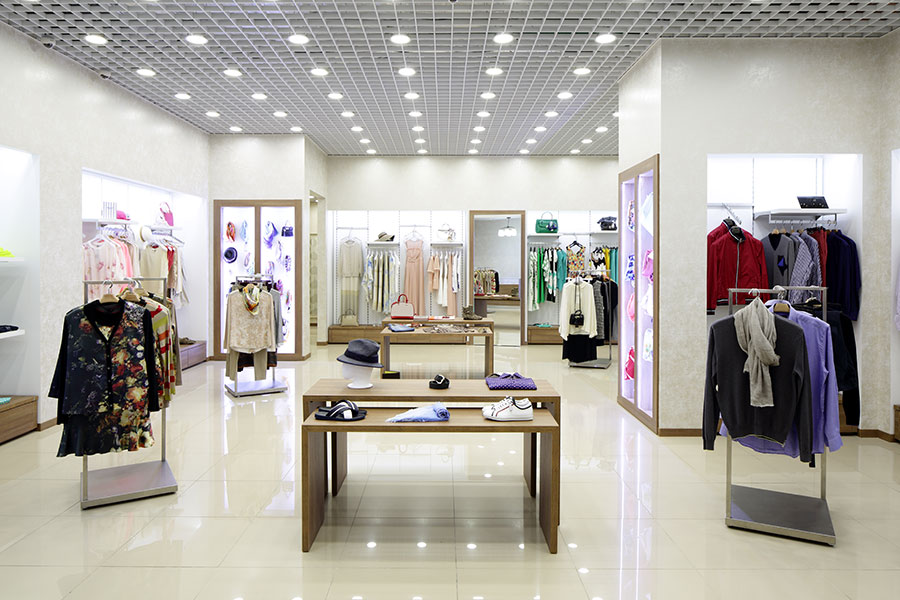The best way to visualize how color will react in real world lighting conditions is to use a quality light booth. Traditional light booths contain common illuminants like daylight, incandescent, and fluorescent to replicate how color will look in the retail store and post-purchase in outdoor and home lighting. Today, the increased use of LED lamps in home, commercial, and retail environments is impacting decades of standardized lighting procedures.
How LED is Changing the Game
LED lights have taken the market by storm over the last few years, largely due to their high efficiency and affordability. According to 2018 data from The National Electrical Manufacturers Association (NEMA), which represents light bulb manufacturers, LED bulbs account for about 65% of the consumer lamp market, followed by halogen incandescent, which account for about 28% of the market.

LED bulbs light a store environment. Image from www.superbrightleds.com.
Many large retailers have already transitioned to LED bulbs to reap the benefits of lower maintenance and repair costs, less energy consumption, and longer lifespan. If your customers are switching, you might be thinking about adding an LED source to your light booth to support them.
Things to Consider Before Adding LED
Adding an LED source will impact your color standards and evaluation procedures.
- Changing light sources can result in noticeable differences in both flare (a change in color of a material when it is viewed in different light sources) and metamerism (when two samples match under one lighting condition but not under another). It is important to monitor flare and metamerism under the new LED source.
- If you have your spectrophotometer set to daylight, your lightbooth set to LED, and your QC software set to fluorescent, your results will be skewed. Be sure your color measurement devices and software can measure and calculate using LED.
- Everyone involved in your production workflow must evaluate color under the same illuminants. Discuss the change with others involved, including your suppliers and customers.
- Since there is not an official LED lighting standard for color matching that maps directly to available LED lamps on the market today, they are best utilized as an additional light source to gauge how the product may appear in an environment illuminated by a similar LED source.
X-Rite's LED Lighting Solutions
Our Judge LED Light Booth is an all-LED, eco-friendly, color evaluation tool that offers instant warm-up and consistent lighting to ensure accurate evaluations across the supply chain. It offers 7 different light sources which can be customized from a wide-range of industry-standard illuminants, including LED D50, D65, LED-B2 3000K, LED 3500K, LED-B3 4000K, UV, A, CWF LED, TL84 LED, U30 LED, and U35 LED.
You can also order the SpectraLight QC with a pre-configured LED source. In addition to CIE Daylight, Cool White Fluorescent, Incandescent "I" and 2300K/Horizon, UVA, and two more fluorescent types (choice of U30, U35, TL83, or TL84), you can choose from two types of LED light sources: The L940 and the L950 for accurate visual color assessment and determination of metamerism.*
If you recently purchased an X-Rite light booth, you don’t need to purchase a new one if you think it is time to integrate LED into your visual assessment process. Our LED Lamp Kits provide excellent color rendering using the same hybrid technology as the LED-BH1 CIE illuminant. They are compatible with all of our current light booths, including SpectraLight QC and Judge QC.**
Simply follow the included instructions to replace your existing 25 watt / T8 fluorescent lamp with a GE LED11ET8/G/x/940 LED lamp with a CCT of 4000k. Although a service call is not necessary for installation, our X-Rite technicians are able to calibrate, repair, and certify with the LED illuminant when the time comes.
Visit our website to learn more about our economical 3-foot and 2-foot LED Lamp Kits and watch an installation video.
Get in touch and our Lighting Experts can answer your questions and help you determine what is right for you.
*Please note that due to the EU ban on fluorescent bulbs, some illuminants are not available in European markets.
**Please be advised that Judge QC is no longer available for purchase in Europe, given the EU ban.

